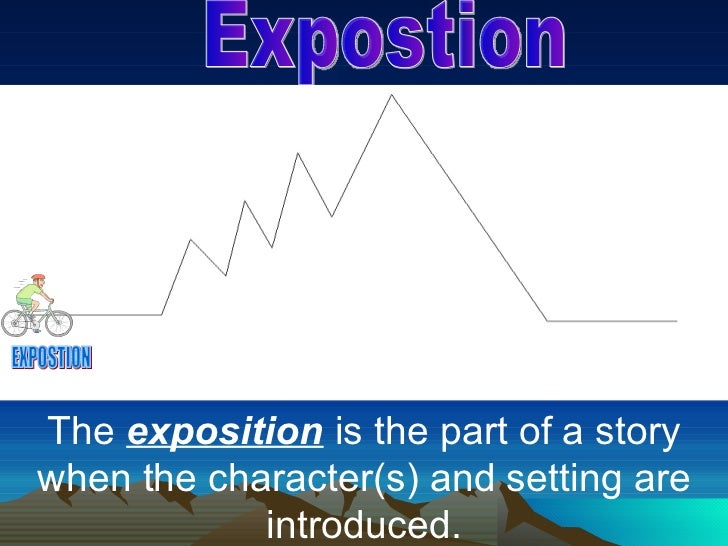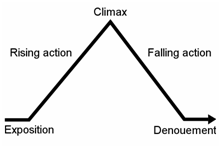When writing for a story, you shouldn't forget to create the plot diagram to guide you in the right corridor. At a glance, it looks like a triangular or pyramid chart. Although the plot diagram templates are easy to get, thanks to the internet, the actual implementation often confusing.
To make the plot diagram, you should know about the basic elements of the plot to make the proper one. You can get the elements from the plot diagram templates you get. But to make your work easier,
6 Elements of Plot Diagram

Here are the plot elements you have to include in your plot diagram based on the parts:
1. Beginning: Exposition
Every story started with an exposition or introduction. This exposition is where you should introduce the story characters. Aside from that, you should also explain the setting and mood the story you're building. This part is important for the story you're building. The exposition takes almost all of the beginning part of the story, and in the plot diagram, it would be pictured as the flat line at the beginning of the graph.
- The exposition is the beginning of a story, where the characters, setting, and problem are introduced. Act One generally introduces the characters and sets up the problem for the play.
- Elements of Plot Exposition sets the scene. The writer introduces the characters and setting, providing description and background. Complication, sometimes called the inciting incident, is a single event that begins the major conflict. Rising Action builds during the story and gets more exciting. Climax is the moment of greatest tension in the.
How to Write a Story Using A Witch's Plot Diagram. Have you ever wanted to write a story, but can't get an effective outline? This strategy is a good way to get a basic outline from the beginning to end of your story.
2. Beginning: Conflict
Besides the exposition, at the first one-third beginning of the story also consist of conflict. In the graphic, it's where the flat line ascends while entering the second one-third part. The conflict is the main problem of the story which builds the plot of the story. Usually, it contains the protagonist goal. Thus, the story plot would build around this to achieve this goal.
3. Middle: Rising Action
The rising action part is where the story will get ascend to reach the climax part. This part consists of several events that would lead up to the climax. Aside from that, here's where the developing of characters would start. If you see the examples from the plot diagram templates printable, then you should stare at the rising graph between conflict until the climax.
4. Middle: Climax
The climax the most exciting part of the story plot and always give thrill when reading the story to reach this part. Many also know this part as the turning point of the story. The reason is where the main character would start to get a change of hearts. And in the graphic, you can see this is the top part of the chart. Also, this is where the character always starts to do things to achieve their goal.
5. Ending: Falling Action
In the plot diagram templates, you will see this part right after the climax where the line started to descend from the top. The falling action is where the story starts to enter the last third of the whole story. Or you can say, this part is heading to the ending. Here, you should elaborate on the result from the climax and start to answer the questions you give in the story. And also, you should wrap up the plot and the characters all well developed.
6. Ending: Resolution

The last part of the plot diagram is where the flat line at the third-last ending. For that reason, you have to ensure that you answered all the questions and unwind the plot. Here, you don't always have to make a happy ending, as long as it completes the story. There are two perspectives in the resolution, one from the author and one from the reader.
For the reader, the good resolution is where they don't have a further question about the plot of the story. Usually, the reader often wishes for a happy ending, even if it's forceful and wouldn't be good for the story. But different from the author, where it's good if the written character could alive in the reader's mind and linger for a long while. Also, even if it ended, the reader could create a continuation of the story. It's the reason, why the likes of Harry Potter have tons of fanfictions.
Plot Diagram
Narrative Plot Structure
Plot Diagram for the Necklace

Plot Diagram Notes for Teacher
Plot Graphic Organizer
Plot Diagram Templates

Here are the plot elements you have to include in your plot diagram based on the parts:
1. Beginning: Exposition
Every story started with an exposition or introduction. This exposition is where you should introduce the story characters. Aside from that, you should also explain the setting and mood the story you're building. This part is important for the story you're building. The exposition takes almost all of the beginning part of the story, and in the plot diagram, it would be pictured as the flat line at the beginning of the graph.
- The exposition is the beginning of a story, where the characters, setting, and problem are introduced. Act One generally introduces the characters and sets up the problem for the play.
- Elements of Plot Exposition sets the scene. The writer introduces the characters and setting, providing description and background. Complication, sometimes called the inciting incident, is a single event that begins the major conflict. Rising Action builds during the story and gets more exciting. Climax is the moment of greatest tension in the.
How to Write a Story Using A Witch's Plot Diagram. Have you ever wanted to write a story, but can't get an effective outline? This strategy is a good way to get a basic outline from the beginning to end of your story.
2. Beginning: Conflict
Besides the exposition, at the first one-third beginning of the story also consist of conflict. In the graphic, it's where the flat line ascends while entering the second one-third part. The conflict is the main problem of the story which builds the plot of the story. Usually, it contains the protagonist goal. Thus, the story plot would build around this to achieve this goal.
3. Middle: Rising Action
The rising action part is where the story will get ascend to reach the climax part. This part consists of several events that would lead up to the climax. Aside from that, here's where the developing of characters would start. If you see the examples from the plot diagram templates printable, then you should stare at the rising graph between conflict until the climax.
4. Middle: Climax
The climax the most exciting part of the story plot and always give thrill when reading the story to reach this part. Many also know this part as the turning point of the story. The reason is where the main character would start to get a change of hearts. And in the graphic, you can see this is the top part of the chart. Also, this is where the character always starts to do things to achieve their goal.
5. Ending: Falling Action
In the plot diagram templates, you will see this part right after the climax where the line started to descend from the top. The falling action is where the story starts to enter the last third of the whole story. Or you can say, this part is heading to the ending. Here, you should elaborate on the result from the climax and start to answer the questions you give in the story. And also, you should wrap up the plot and the characters all well developed.
6. Ending: Resolution
The last part of the plot diagram is where the flat line at the third-last ending. For that reason, you have to ensure that you answered all the questions and unwind the plot. Here, you don't always have to make a happy ending, as long as it completes the story. There are two perspectives in the resolution, one from the author and one from the reader.
For the reader, the good resolution is where they don't have a further question about the plot of the story. Usually, the reader often wishes for a happy ending, even if it's forceful and wouldn't be good for the story. But different from the author, where it's good if the written character could alive in the reader's mind and linger for a long while. Also, even if it ended, the reader could create a continuation of the story. It's the reason, why the likes of Harry Potter have tons of fanfictions.
Plot Diagram
Narrative Plot Structure
Plot Diagram for the Necklace
Plot Diagram Notes for Teacher
Plot Graphic Organizer
Plot Diagram Templates
Plots D'exposition
To wrap this up, you can study from the plot diagram templates PDF that you can find here. There are many models, but the basic always same. The difference is the interval of each part and how much each of them takes the timeline.
Blank Plot Diagram Templates
Plot Diagram Templates for Eleven
Plot Diagram Templates Worksheet
Short Story Plot Diagram Templates
Exposition Plot Element
Scatter Plot Diagram Templates
Plots Exposition
Plot Diagram Templates PDF
| File | Description | File size | Downloads |
|---|---|---|---|
| Plot Diagram Templates | 26 KB | 439 |

